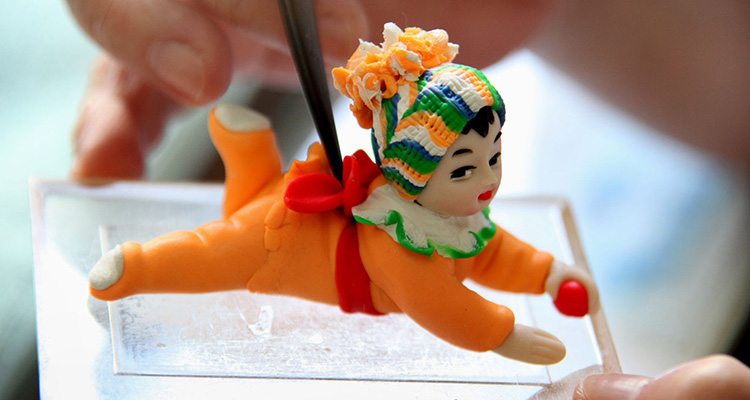Beijing Clay Figurine Art: The Magical Dough Sculptures at Your Fingertips
In the lively temple fairs or quiet hutongs of Beijing, you might spot a small stall that instantly catches your eye. With quick and skillful fingers, an artist transforms a lump of colored dough into the Monkey King, a cute panda, or even a flying dragon in just a few minutes.
This is Beijing Clay Figurine Art, known locally as Nian Ren. It’s more than just a craft — it’s a century-old art of the fingertips, giving life and soul to simple dough made from glutinous rice flour.
1. What Is It? A Three-Dimensional Chinese Fairy Tale
When you first see a clay figurine, you’ll be amazed by how vivid and expressive it is. Unlike paintings on paper, these are three-dimensional, touchable folk artworks.
You can think of them as “mini Chinese cartoon sculptures in your palm.”
With bright colors, smooth lines, and exaggerated facial expressions, each figurine tells a story — often inspired by Chinese mythology or daily life. From heroic warriors to playful children, clay figurines bring traditional Chinese culture to life, especially for young visitors who fall in love with them at first sight.

2. A Thousand-Year Legend Hidden in Dough
The history of clay figurines dates back to the Han Dynasty, when they were first used in sacrificial rituals. Over time, they evolved into a beloved folk art enjoyed by ordinary people.
In Beijing, this craft is deeply connected with local culture.
Old Beijingers often say, “Making figurines brings good fortune.”
Each piece carries a symbolic blessing — the Monkey King represents bravery and wit, goldfish symbolize abundance, and longevity peaches bring health and long life. These tiny figurines are actually lucky charms filled with hope and good wishes.

3. The Magic of Fingers: Skill in Every Pinch
Bringing dough to life relies entirely on the artist’s fingertips:
- Unique Ingredients: The dough is made from wheat and glutinous rice flour, mixed with honey and glycerin. This special recipe prevents cracking and mold.
- Simple Tools: With only a bamboo stick, small knives, and scissors, artists can create a whole world of characters.
- Traditional Techniques: Through pressing, pinching, rolling, and shaping, combined with special skills known as “press, pinch, attach, and roll,” a lifelike figurine appears within minutes.

4. How to Appreciate Clay Figurines
Understanding these small artworks is about reading their visual language:
- Look at the Spirit: The best figurines capture emotions and movement — a glance or gesture can tell an entire story.
- Notice the Details: Pay attention to clothing folds, armor patterns, or tiny accessories that reveal the artist’s craftsmanship.
- Recognize the Classics: Popular figures include the Monkey King (Sun Wukong), the humorous Pigsy (Zhu Bajie), and traditional Beijing characters like the Rabbit God (Tu’er Ye).
When you encounter a clay figurine stall, take a moment to watch. Many artists offer live demonstrations, and some even let you customize your own unique figurine — a fun, hands-on experience.

5. Where to Experience This Living Craft
If you want to see or try this art yourself, here are some of the best places in Beijing:
- Temple Fairs: During the Spring Festival, the Ditan Temple Fair and Longtan Temple Fair host numerous clay artists displaying their creations.
- Famous Streets: In Nanluoguxiang and Yandai Xiejie, you’ll often find permanent stalls selling traditional figurines.
- Cultural Museums: The Beijing Arts and Crafts Museum exhibits exquisite figurines and regularly holds workshops.
- Hands-on Studios: Many studios, such as those in the 77 Cultural and Creative Park, offer short clay figurine classes guided by professional artisans.
Next time you stroll through Beijing and spot a tiny stall with colorful dough figures, stop for a while. The artist sitting on a small stool isn’t just shaping clay — they’re preserving a piece of old Beijing’s soul.
Take one home as a keepsake; it’s not just a souvenir, but a story you can hold in your hand.


